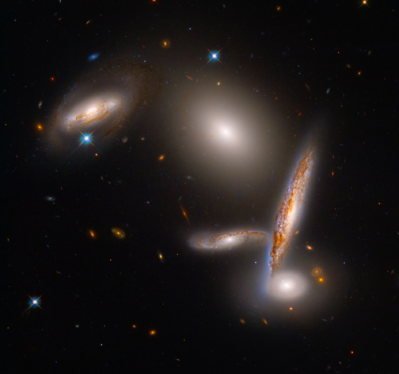5 min read
NASA’s New Hubble E-Book Spotlights Universe’s Best-Kept Dark Secrets

NASA’s Hubble Space Telescope team has released a new downloadable e-book in the Hubble Focus series, called “Hubble Focus: The Dark Universe.” This e-book highlights the mission’s recent discoveries about two mysterious components of our universe, known as dark energy — an unexplained cosmic pressure that’s speeding up the universe’s expansion — and dark matter, an invisible substance detectable only by seeing how it gravitationally influences visible matter.
Download:
“This new e-book is a wonderful summary of all the work that Hubble, in cooperation with other observatories on the ground and in space, has put into improving our understanding of two of the biggest mysteries in astrophysics today: the true nature and origin of dark matter and dark energy,” said Ken Carpenter, Hubble’s operations project scientist. “Much remains to be done, but this book will give you a front row seat to what’s been happening in this quest!”

A Cosmic Ghost Hunt
The trillions of stars, planets, galaxies, and other visible objects strewn throughout the cosmos represent less than 5 percent of what’s truly out there. Visible matter is like the tip of an iceberg, or the foam on top of a latte. All the rest of the universe, dark matter and dark energy, is mired in mystery.
Dark matter is a phantom in the machinery of the universe. Though it makes up the vast majority of the universe’s bulk, dark matter would evade even the best “ghost hunters” because it’s invisible, detectable only through its effects on normal matter. Its gravitational pull is the muscle of the cosmos, holding together both individual galaxies and galaxy clusters. Although scientists have long seen evidence of its existence, dark matter’s true nature remains one of the biggest mysteries in modern physics.
Hubble’s cosmic detective work offers clues by exploring the way matter, both normal and dark, is structured and distributed throughout space. Some of the mission’s observations have even tested theories about the type of particle that could make up dark matter. But Hubble’s observations haven’t always matched predictions, hinting that our theoretical models still have several missing pieces.
Under Pressure
Shock waves of surprise rippled through the scientific community in 1998, when Hubble observations of supernovae in more distant galaxies helped show that the universe actually expanded more slowly in the past than it does today. That meant the expansion of the universe was not slowing down due to the attractive force of gravity, as many thought it should — it was speeding up.
Today, we still don’t know the exact cause of this mysterious acceleration, but theoretical cosmologists coined the term “dark energy” to describe it. Dark energy is so weak that gravity overpowers it on the scale of humans, planets, and even within the galaxy, which is why it was unobserved for so long.

Dark energy is present in the room with you as you read, even within your body, but gravity is much stronger at smaller scales, which is why you don’t fly out of your seat. It is only on an intergalactic scale that dark energy becomes noticeable — and since it’s everywhere, it even overwhelms the dark matter! Hubble has helped gather very precise measurements of the universe’s expansion rate, but its findings underscore a nagging discrepancy. The universe is expanding faster now than was expected from its trajectory seen shortly after the big bang, and no one yet knows why.
The perplexity surrounding dark energy and dark matter indicates that for all we’ve learned about the universe, we still don’t know much about its underpinnings. Studying these mysteries opens the door to discovering exciting new physics.
“Hubble’s incredible scientific power continues to drive modern astronomy,” said Jennifer Wiseman, Hubble’s senior project scientist. “Dark matter and dark energy were not in mind when Hubble was first designed, and yet by detecting the impacts of these unseen cosmic phenomena, the Hubble Space Telescope is once again transforming our understanding of the universe.”
Scientists will expand upon Hubble’s insights about dark matter and dark energy with complementary observations from the European Space Agency’s Euclid mission, which has NASA contributions; NASA’s upcoming Nancy Grace Roman Space Telescope, and variety of other space and ground-based telescopes. We have far more left to learn among the stars.
As the fifth edition of the series, this e-book builds on the wealth of information shared in previous renditions, which focused on the solar system, galaxies, stars, and exoplanets. Upcoming editions will zoom in on other cosmic topics, such as black holes – astronomical objects with such strong gravity that nothing, not even light, can escape their clutches.
The new e-book is compatible with most electronic devices and can be downloaded in multiple formats for free from: https://science.nasa.gov/mission/hubble/multimedia/e-books.
For more information about Hubble, visit: www.nasa.gov/hubble
By Ashley Balzer
NASA’s Goddard Space Flight Center, Greenbelt, MD
Media Contact:
Claire Andreoli
NASA’s Goddard Space Flight Center, Greenbelt, MD
claire.andreoli@nasa.gov








